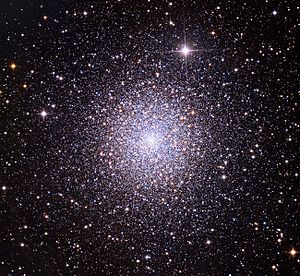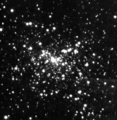| Messier 15 | |
|---|---|
 Deep Broadband (RGB) image of M15 Deep Broadband (RGB) image of M15 | |
| Observation data (J2000 epoch) | |
| Class | IV |
| Constellation | Pegasus |
| Right ascension | 21 29 58.33 |
| Declination | +12° 10′ 01.2″ |
| Distance | 35.69 ± 0.43 kly (10.944 ± 0.131 kpc) |
| Apparent magnitude (V) | 6.2 |
| Apparent dimensions (V) | 18′.0 |
| Physical characteristics | |
| Mass | 5.6×10 M☉ |
| Radius | ~88 ly |
| VHB | 15.83 |
| Metallicity | = –2.37 dex |
| Estimated age | 12.0 Gyr |
| Notable features | steep central cusp |
| Other designations | NGC 7078, GCl 120 |
| See also: Globular cluster, List of globular clusters | |
Messier 15 or M15 (also designated NGC 7078 and sometimes known as the Great Pegasus Cluster) is a globular cluster in the constellation Pegasus. It was discovered by Jean-Dominique Maraldi in 1746 and included in Charles Messier's catalogue of comet-like objects in 1764. At an estimated 12.5±1.3 billion years old, it is one of the oldest known globular clusters.
Characteristics
M 15 is about 35,700 light-years from Earth, and 175 light-years in diameter. It has an absolute magnitude of −9.2, which translates to a total luminosity of 360,000 times that of the Sun. Messier 15 is one of the most densely packed globulars known in the Milky Way galaxy. Its core has undergone a contraction known as "core collapse" and it has a central density cusp with an enormous number of stars surrounding what may be a central black hole.
Home to over 100,000 stars, the cluster is notable for containing a large number of variable stars (112) and pulsars (8), including one double neutron star system, M15-C. It also contains Pease 1, the first planetary nebula discovered within a globular cluster in 1928. Just three others have been found in globular clusters since then.
Amateur astronomy
At magnitude 6.2, M15 approaches naked eye visibility under good conditions and can be observed with binoculars or a small telescope, appearing as a fuzzy star. Telescopes with a larger aperture (at least 6 in. (150 mm)) will start to reveal individual stars, the brightest of which are of magnitude +12.6. The cluster appears 18 arc minutes in size (three tenths of a degree across). M15 is around 4° WNW of the brightest star of Pegasus, Epsilon Pegasi.
X-ray sources
Earth-orbiting satellites Uhuru and Chandra X-ray Observatory have detected two bright X-ray sources in this cluster: Messier 15 X-1 (4U 2129+12) and Messier 15 X-2. The former appears to be the first astronomical X-ray source detected in Pegasus.
Gallery
-
 The central square arcminute of M15 imaged using the lucky imaging technique
The central square arcminute of M15 imaged using the lucky imaging technique
-
 Map showing the location of M15
Map showing the location of M15
-
 M15 photographed by HST. The planetary nebula Pease 1 can be seen as a small blue object to the upper left of the core of the cluster.
M15 photographed by HST. The planetary nebula Pease 1 can be seen as a small blue object to the upper left of the core of the cluster.
See also
References
- Shapley, Harlow; Sawyer, Helen B. (August 1927). "A Classification of Globular Clusters". Harvard College Observatory Bulletin. 849 (849): 11–14. Bibcode:1927BHarO.849...11S.
- ^ Goldsbury, Ryan; et al. (December 2010). "The ACS Survey of Galactic Globular Clusters. X. New Determinations of Centers for 65 Clusters". The Astronomical Journal. 140 (6): 1830–1837. arXiv:1008.2755. Bibcode:2010AJ....140.1830G. doi:10.1088/0004-6256/140/6/1830. S2CID 119183070.
- ^ Bhardwaj, Anupam; Rejkuba, Marina; Sloan, G. C.; Marconi, Marcella; Yang, Soung-Chul (2021). "Optical and Near-infrared Pulsation Properties of RR Lyrae and Population II Cepheid Variables in the Messier 15 Globular Cluster". The Astrophysical Journal. 922 (1): 20. arXiv:2108.11388. Bibcode:2021ApJ...922...20B. doi:10.3847/1538-4357/ac214d. S2CID 237304172.
- "Messier 15". SEDS Messier Catalog. Retrieved 21 July 2024.
- Marks, Michael; Kroupa, Pavel (August 2010). "Initial conditions for globular clusters and assembly of the old globular cluster population of the Milky Way". Monthly Notices of the Royal Astronomical Society. 406 (3): 2000–2012. arXiv:1004.2255. Bibcode:2010MNRAS.406.2000M. doi:10.1111/j.1365-2966.2010.16813.x. S2CID 118652005. Mass is from MPD on Table 1.
- distance × sin( diameter_angle / 2 ) = 88 ly radius
- Boyles, J.; et al. (November 2011). "Young Radio Pulsars in Galactic Globular Clusters". The Astrophysical Journal. 742 (1): 51. arXiv:1108.4402. Bibcode:2011ApJ...742...51B. doi:10.1088/0004-637X/742/1/51. S2CID 118649860.
- Koleva, M.; et al. (April 2008). "Spectroscopic ages and metallicities of stellar populations: validation of full spectrum fitting". Monthly Notices of the Royal Astronomical Society. 385 (4): 1998–2010. arXiv:0801.0871. Bibcode:2008MNRAS.385.1998K. doi:10.1111/j.1365-2966.2008.12908.x. S2CID 17571531.
- "M 15". SIMBAD. Centre de données astronomiques de Strasbourg. Retrieved 2006-11-16.
- O'Malley, Erin M.; Gilligan, Christina; Chaboyer, Brian (April 2017). "Absolute Ages and Distances of 22 GCs Using Monte Carlo Main-sequence Fitting". The Astrophysical Journal. 838 (2): 162. arXiv:1703.01915. Bibcode:2017ApJ...838..162O. doi:10.3847/1538-4357/aa6574. S2CID 11852378.
- ^ "M 15". astropix.
- Gerssen J, van der Marel RP, Gebhardt K, Guhathakurta P, Peterson RC, Pryor C (2003). "Evidence for an intermediate-mass black hole in the globular cluster M 15. II. Kinematic analysis and dynamical modeling". Astronomical Journal. Hubble Space Telescope. 125 (1): 376–377. arXiv:astro-ph/0210158. Bibcode:2003AJ....125..376G. doi:10.1086/345574. S2CID 118948032.
- Cohen, J.G.; Gillett, F.C. (1989). "The peculiar planetary nebula in M 22" (PDF). Astrophysical Journal. 346: 803–807. Bibcode:1989ApJ...346..803C. doi:10.1086/168061. S2CID 119770028.
- ^ O'Meara, Stephen James; Levy, David H. (1998), Deep-Sky Companions: The Messier Objects, Cambridge University Press, p. 74, ISBN 978-0521553322.
- "more". SEDS.org. Messier 15.
- Forman W; Jones C; Cominsky L; Julien P; Murray S; Peters G (1978). "The fourth Uhuru catalog of X-ray sources". Astrophysical Journal Supplement Series. 38: 357. Bibcode:1978ApJS...38..357F. doi:10.1086/190561.
- White NE; Angelini L (2001). "The discovery of a second luminous low-mass X-ray binary in the globular cluster M15". Astrophysical Journal Letters. 561 (1): L101–5. arXiv:astro-ph/0109359. Bibcode:2001ApJ...561L.101W. doi:10.1086/324561. S2CID 18877294.
External links
- Messier 15, SEDS Messier pages
- Messier 15, Galactic Globular Clusters Database page
- Globular Cluster Photometry With the Hubble Space Telescope. V. WFPC Study of M15's Central density Cusp
- Wikisky.org SDSS image of M15
- Gretton, Roy; Gray, Meghan. "M15 – Globular Cluster". Deep Sky Videos. Brady Haran.
- Messier 15 on WikiSky: DSS2, SDSS, GALEX, IRAS, Hydrogen α, X-Ray, Astrophoto, Sky Map, Articles and images
| Astronomical catalogs | |
|---|---|
| Messier | |
| NGC | |
| Messier objects | ||
|---|---|---|
| List |
|  |
| See also | ||
 = –2.37
= –2.37